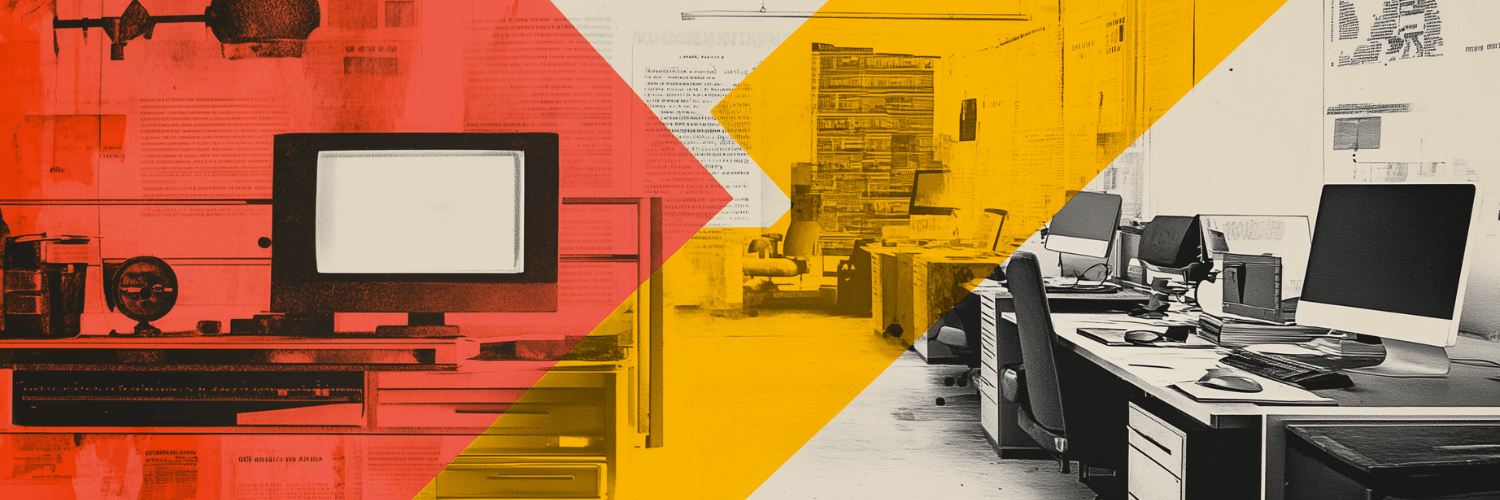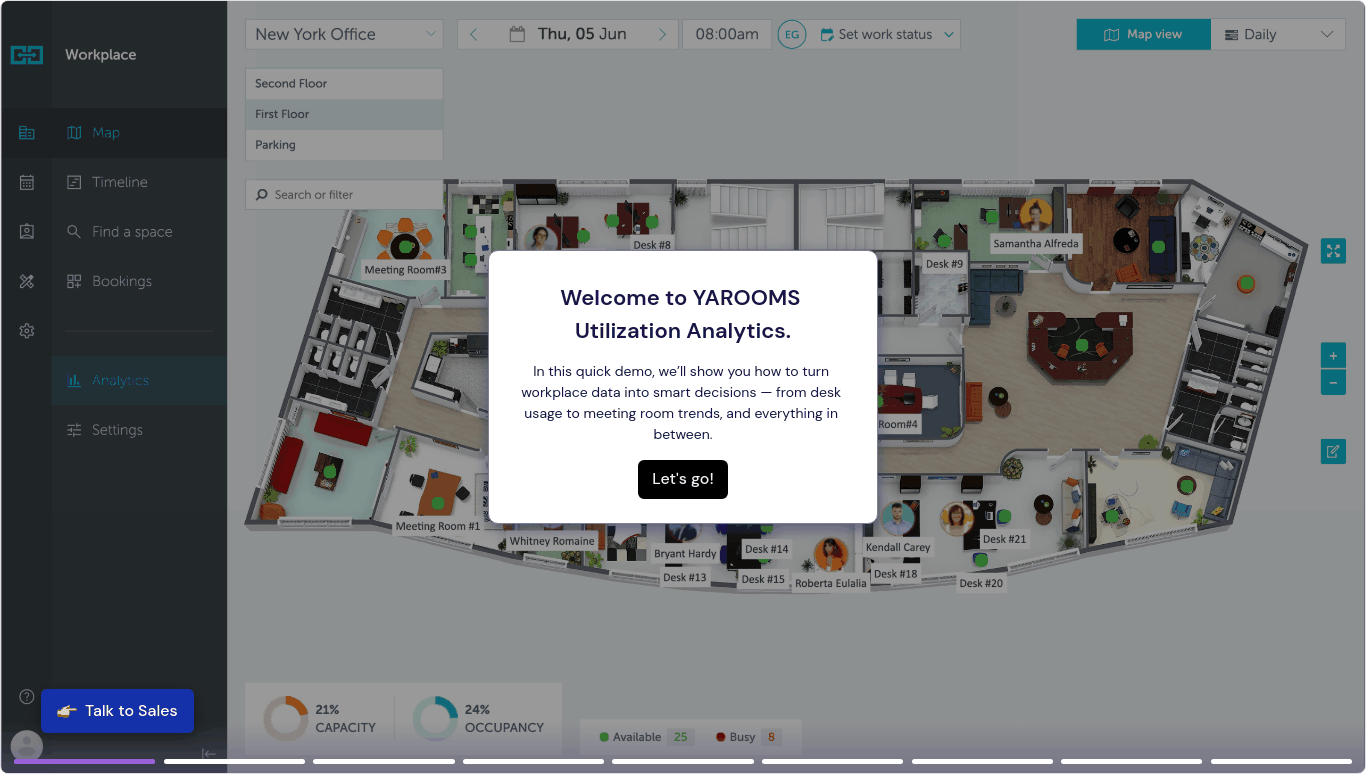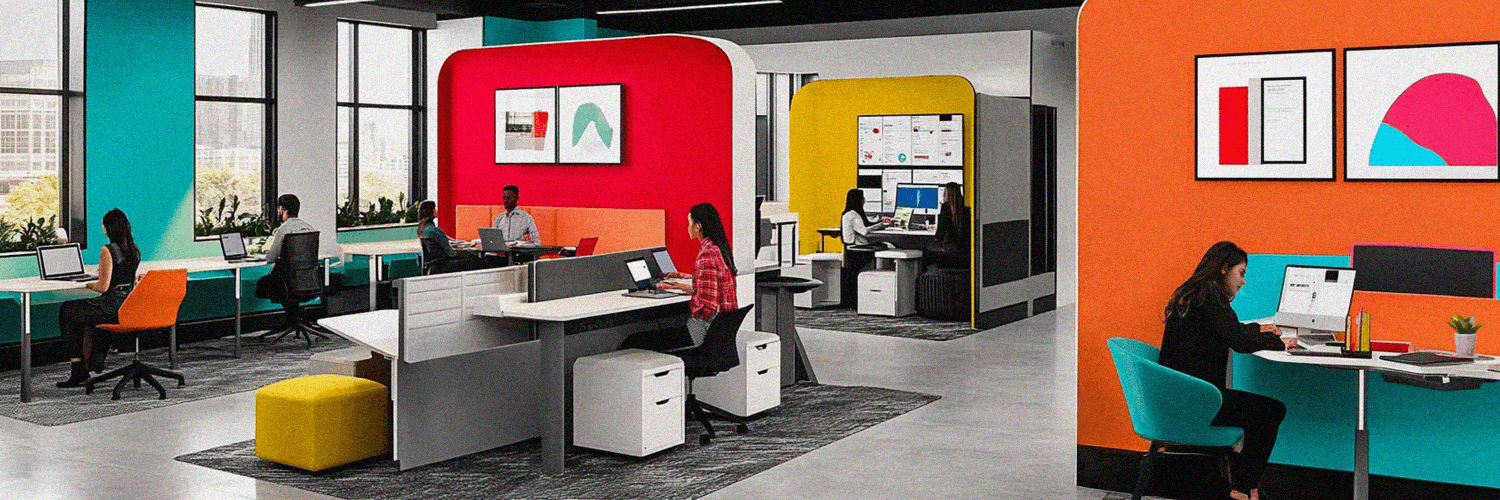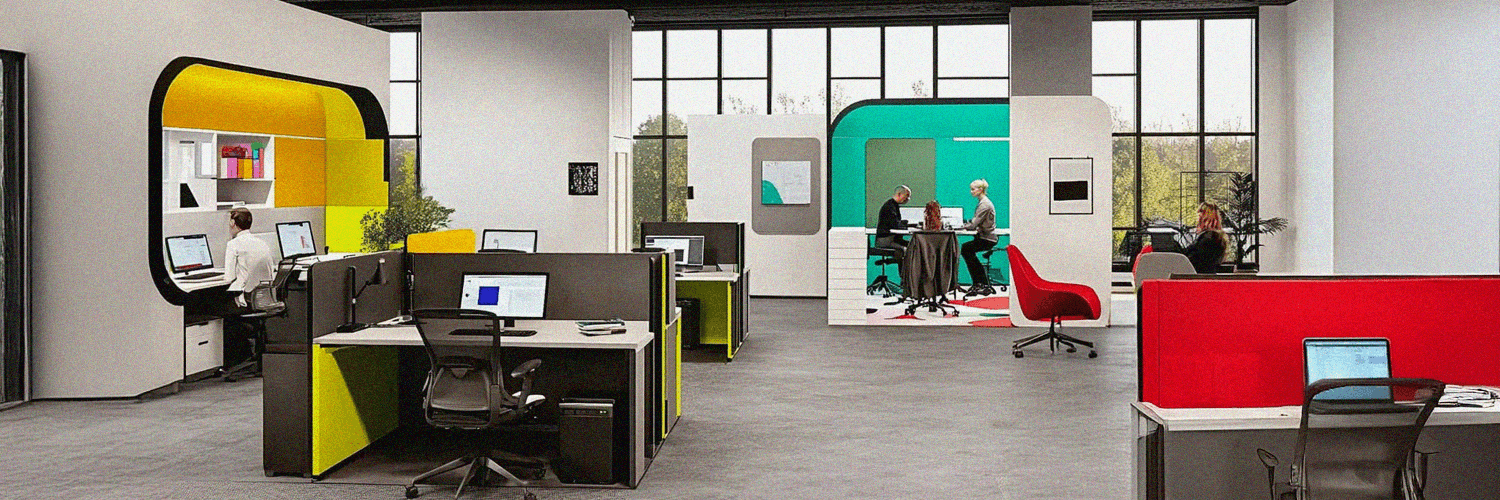Picture this: a bustling office filled with the clatter of typewriters, the rustle of paper, and the constant ring of landline phones. Now, fast-forward to today's workplace—a seamless blend of virtual meetings, cloud-based collaboration, and AI-driven productivity tools. The transformation is nothing short of revolutionary. Technology has not just changed how we work; it has redefined the essence of the modern workplace and the modern workforce.
According to a 2024 McKinsey Global Survey, 93% of organizations have adopted, or have plans to adopt, a digital-first business strategy, highlighting the widespread digital transformation across industries. From the humble beginnings of desktop computers to the era of automation and remote work, workplace technology's journey is a testament to human innovation.
But how exactly has this technological revolution impacted workers' professional lives? How has technology changed the way we work, and what are the benefits of technology in the workplace? How has it reshaped our daily routines?
In this article, we'll explore the fascinating and ever-evolving landscape of workplace technology, delve into its far-reaching effects, and uncover how it continues to shape the future of work. Whether you're a tech enthusiast or simply curious about the changing face of the modern office, buckle up for an enlightening journey through the digital transformation of our work lives.
TL;DR:
- Transformation of Workplaces: Technology has fundamentally changed the way we work, communicate, and collaborate, enhancing productivity, flexibility, and efficiency.
- Remote Work and AI Integration: The rise of remote work and AI automation apps has pushed workplace boundaries, creating more flexible environments.
- Evolving Office Dynamics: The traditional office has evolved into a technological hub of innovation, with smart devices, cloud computing, and advanced communication tools.
- Employee Experience Focus: Technology significantly impacts employee satisfaction, with 59% of employees who use AI tools reporting greater job satisfaction.
- Workplace Analytics Revolution: Data-driven decision making has become essential, with analytics enabling better space utilization, cost reduction, and employee experience improvements.
- Future Technological Advancements: Emerging technologies like agentic AI, edge intelligence, and hybrid computing will further transform workplace dynamics by 2025.
- Security Challenges: With 95% of data breaches involving human error, organizations must prioritize cybersecurity training and robust systems.
- Human-Centric Workplaces: Successful organizations balance technological advancement with human needs, creating environments that are innovative, inclusive, collaborative, and fulfilling.
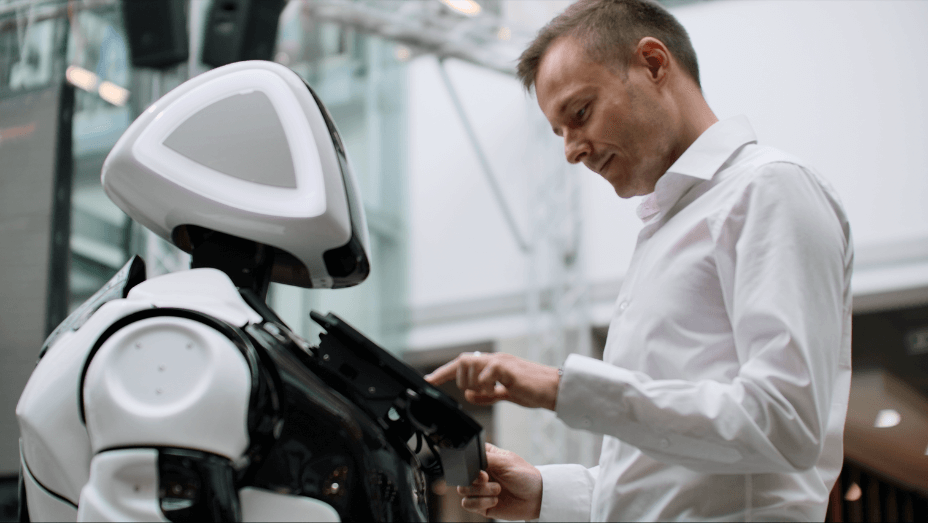
The Evolution of Workplace Technology: From Typewriters to AI
The evolution of workplace technology is a captivating story of innovation and adaptation. It begins with simple mechanical tools and culminates in the sophisticated digital ecosystems we navigate today. This journey showcases the positive impact of tech in the workplace and how it has fundamentally altered how we approach our professional lives.
Let's take a trip down memory lane to understand this transformation better:
1960s-1970s: The Mechanical Era
The workplace was dominated by typewriters, filing cabinets, rotary phones, and predominantly manual work. Information traveled slowly, and most business processes required significant human intervention and physical presence.
1980s: The Personal Computer Revolution
The introduction of personal computers marked the first significant shift towards digital workplaces. Suddenly, tasks that once took hours could be completed in minutes, and information storage became more efficient and accessible. Word processing, spreadsheets, and early database applications began transforming office productivity.
1990s: The Internet and Email Era
The 1990s brought us the internet, email, and the first wave of mobile phones. These technologies revolutionized communication, allowing for instant messaging and remote collaboration. The concept of being "always connected" began to take shape, blurring the lines between work and personal life. Industrial automation also began to reshape various aspects of life and work, enhancing efficiency and convenience.
2000s: The Mobile and Cloud Revolution
As we entered the new millennium, cloud computing emerged as a game-changer. It allowed for unprecedented data storage and sharing capabilities, paving the way for more optimized workflows and flexible work arrangements. The rise of smartphones and tablets in the late 2000s further supported this shift by making communication easier.
2010s: Social Collaboration and Big Data
Enterprise social networks, team collaboration platforms, and big data analytics transformed how organizations share knowledge and make decisions. These technologies fostered more collaborative work cultures and enabled data-driven strategies that were previously impossible.
2020s: AI, Automation, and Hybrid Work
Today, artificial intelligence, machine learning, and the Internet of Things (IoT) - powered by efficient gpu cloud hosting - are reshaping the workplace landscape. These technologies automate routine tasks, provide data-driven insights, and enable more intelligent, responsive work environments.
Recent studies highlight the rapid acceleration of AI adoption, with 75% of surveyed workers using AI in their workplace by 2024, nearly half adopting it within just the last six months.
The COVID-19 pandemic dramatically accelerated digital transformation, with organizations implementing years' worth of technology changes in just months to support remote and hybrid work models.
The benefits of technology in the workplace are numerous and far-reaching. It has enhanced productivity, improved communication, enabled remote work, and opened up new avenues for innovation. However, it's also important to acknowledge the challenges of this rapid technological advancement, such as privacy concerns, the need for continuous learning, and the potential for increased work-related stress.
Adaptability is key as we continue to witness how tech has changed the workplace. The modern worker must be willing to embrace new tools and apps to stay relevant in an ever-evolving job market. Technology in workplace settings continues to advance at a breakneck pace, promising even more exciting developments for both employers and employees.
Six Ways Technology Has Reshaped the Modern Workplace
The integration of new workplace technology has dramatically transformed the way we work, communicate, and collaborate. Let's explore six detailed examples of how digital technology in the workplace has reshaped our professional landscape.
1. The Hybrid Work Revolution: Technology Enabling Flexibility
One of the most significant changes in recent years has been the widespread adoption of remote and hybrid work. New office technology has made it possible for employees to work from anywhere at any time, with transformative results.
The hybrid work model has emerged as the preferred arrangement for many organizations, with employees working in the office 2.49 days per week on average. This structured approach balances in-person collaboration with remote flexibility, as most of companies have adopted this model to maximize productivity while maintaining work-life balance.
Essential technologies enabling hybrid work include:
- Cloud-based productivity suites like Google Workspace and Microsoft 365 allowing seamless real-time collaboration
- VPNs and secure remote desktop solutions providing secure access to company resources
- Video conferencing platforms like Zoom and Microsoft Teams supporting virtual meetings and collaboration
- Project management tools like Asana, Trello, and Monday.com for task assignments and team coordination
- Hybrid scheduling platforms like YAROOMS that coordinate when employees work in-office versus remotely, ensuring teams can collaborate effectively
2. Communication and Collaboration: Breaking Geographical Barriers
Digital communication technology in the workplace has revolutionized how employees collaborate across distances. Modern collaboration platforms combine multiple functions into unified experiences:
- Unified messaging platforms like Slack and Microsoft Teams have emerged as powerful communication hubs, combining instant messaging, file sharing, and integration with other workplace tools
- Cloud-based file storage services like Dropbox and Google Drive provide seamless access to documents from anywhere
- Digital whiteboards like Miro and MURAL enable virtual brainstorming and visual collaboration
- Asynchronous video tools like Loom allow for rich communication across time zones and schedules
- Digital signage in the workplace displays real-time information about meeting room availability and in-office events, enhancing space management and keeping employees informed about what's happening around the office
3. Automation and AI: Enhancing Human Potential
Automation and Artificial Intelligence (AI) represent a significant leap in workplace technology. From chatbots handling customer queries to AI-powered analytics tools providing business insights, these technologies streamline workflows and boost productivity across industries.
Recent implementation examples include:
- Robotic Process Automation (RPA) automating manual tasks in fields like finance and human resources, freeing employees to focus on strategic work
- AI writing assistants like Grammarly and AI Grammar Corrector, enhancing communication quality across organizations
- Voice assistants and natural language processing simplifying interactions with workplace systems
- AI-powered workplace assistants like YAROOMS Yarvis, revolutionizing how employees interact with their workspace by simplifying desk booking and meeting room management
Rather than replacing jobs, thoughtfully implemented AI is augmenting human capabilities and creating more engaging work experiences. The evidence bears this out—approximately 89% of employees believe AI improves their workload by enhancing decision-making and creativity, while 51% report achieving a healthier work-life balance thanks to AI-enabled efficiency.
4. Space Management Technologies: Optimizing Hybrid Workplaces
Space management tools have become crucial as businesses adapt to hybrid work models. These technologies help optimize office layouts, automate desk bookings, and track space utilization with impressive results.
Advanced space management solutions include:
- Desk booking systems allowing employees to reserve workspaces in advance
- Meeting room management platforms optimizing the use of collaboration spaces
- Occupancy sensors providing real-time data on space utilization
- Space analytics tools helping facilities managers make data-driven decisions
A strong example of this in action is YAROOMS, whose space management platform has helped organizations improve space utilization by 30–40%. By streamlining desk and meeting room booking, YAROOMS has also contributed to higher employee satisfaction and smoother transitions to hybrid workplace strategies.
5. Workplace Experience Platforms: The All-in-One Solution
Workplace experience software has emerged as a comprehensive solution for managing every aspect of the modern workplace. These platforms integrate multiple functions:
- Desk and room booking systems streamlining office resource management
- Visitor management enhancing security and guest experiences
- Hybrid work planning tools supporting flexible schedules
- Employee experience features fostering connection and engagement
YAROOMS' workplace experience platform exemplifies this comprehensive approach, offering an integrated solution that supports flexible, hybrid work environments while prioritizing employee satisfaction. The platform's AI workplace assistant, Yarvis, further enhances the experience by making interactions with workplace systems more intuitive and conversational.
As organizations increasingly focus on creating engaging, efficient, and human-first workplaces, these comprehensive platforms are becoming essential tools for workplace transformation.
6. Sustainability Technologies: Creating Greener Workplaces
As environmental concerns take center stage, new workplace technology is helping organizations reduce their carbon footprint and operate more sustainably:
- Smart building systems optimize energy usage through IoT sensors
- Carbon footprint calculators help track environmental impact
- Energy management platforms identify opportunities for conservation
- Remote work technologies reduce commute-related emissions
A notable example comes from New York Life's implementation of the Carbon Savings Account (CSA) program, which allowed employees to make sustainable home and transportation upgrades. This initiative reduced annual utility bills by over $11,000 and lowered carbon emissions equivalent to removing five homes from the electrical grid, with 94% employee satisfaction with the program.
The Impact of Technology on Employee Experience and Well-Being
As workplace technology advances, its impact on employee experience and well-being has become a critical consideration for organizations. Technology can significantly enhance the employee journey when implemented thoughtfully, but it also presents challenges that must be addressed.
Enhancing Employee Satisfaction through Technology
Digital tools are increasingly central to employee satisfaction and engagement. Recent implementations show promising results:
- Flexible work technologies support hybrid work models, helping employees achieve better work-life balance, reduce commute-related stress, and gain greater autonomy in how they manage their time.
Recognition platforms that enable peer-to-peer acknowledgment contribute to higher morale and deeper engagement by fostering a culture of appreciation and continuous feedback. - Learning and development systems, especially those powered by AI, offer personalized development pathways that support skill growth and career advancement, contributing to long-term job satisfaction.
For example, YAROOMS' workplace experience platform contributes to employee well-being by giving workers greater autonomy over their work environment through intuitive desk booking, meeting room management, and hybrid schedule coordination, all of which reduce workplace friction and enhance the daily experience.
Addressing Technology-Related Stress and Burnout
While technology offers numerous benefits, it can also contribute to workplace stress when not managed effectively:
- Digital overload: The proliferation of communication channels can lead to information overload and constant interruptions. Organizations are implementing "digital detox" periods and communication guidelines to address this issue.
- Work-life boundary erosion: Always-on technologies can blur the lines between professional and personal life. Companies are establishing clear expectations around after-hours communications to protect employee wellbeing.
- Monitoring concerns: Electronic monitoring of employees reduces job satisfaction and increases stress levels while having no effect on performance, highlighting the importance of transparent, trust-based approaches to workplace technology.
- Technology adoption stress: Rapid technological change can create anxiety for workers concerned about keeping pace. Progressive organizations are addressing this through comprehensive training programs and change management approaches.

Creating Inclusive Digital Workplaces
Technology also plays a crucial role in creating more inclusive workplaces:
- Accessibility features: Modern workplace tools now include screen readers, captioning, transcription services, and other accessibility features that make digital environments more inclusive for employees with disabilities.
- Translation tools: AI-powered translation enables more effective cross-cultural collaboration, breaking down language barriers between global team members.
- Flexible work options: Technology-enabled flexible work arrangements have expanded opportunities for parents, caregivers, and those with mobility challenges, creating more diverse and inclusive teams.
Organizations that thoughtfully implement workplace technology with employee well-being in mind see substantial benefits in terms of satisfaction, retention, and productivity.
As workplaces continue to evolve, balancing technological advancement with human needs will remain essential for creating positive employee experiences.
Security and Privacy Concerns in the Digital Workplace
As automation technology reshapes work environments, it introduces significant security and privacy challenges that organizations must address. The rapid adoption of digital tools, especially in remote work settings, has created new vulnerabilities that require robust protection strategies.
Emerging Security Challenges in Modern Work Environments
The digital workplace faces several critical security threats:
- Expanded attack surface: Remote and hybrid work has extended corporate networks beyond traditional boundaries, creating new entry points for cyber threats.
- Cloud service vulnerabilities: As organizations shift to cloud-based solutions, securing data across multiple platforms becomes increasingly complex.
- IoT device risks: Smart office technologies increase connectivity but also introduce potential security gaps if not properly managed.
- Human error: Most of data breaches are caused by human error, making employee security awareness crucial.
- Sophisticated phishing attacks: Social engineering tactics have become more targeted and convincing, particularly in remote settings where verification is more difficult.
Balancing Security with Employee Privacy
Organizations must navigate the delicate balance between security monitoring and employee privacy:
- Ethical monitoring practices: While security tools can track user activity to identify threats, they must be implemented transparently and with clear policies.
- Data minimization principles: Collecting only necessary data and limiting access helps protect both organizational and personal information.
- Regulatory compliance: Companies must adhere to evolving privacy regulations like GDPR and CCPA while maintaining security protocols.
- Trust-based approaches: Excessive surveillance can damage morale and trust; organizations should focus on security awareness rather than intrusive monitoring.
Implementing Robust Security in Modern Workplaces
To address these challenges, organizations are adopting comprehensive security strategies:
- Zero trust architecture: This approach operates on the principle "never trust, always verify," requiring authentication for all users regardless of location.
- Multi-factor authentication (MFA): Adding additional verification layers significantly reduces unauthorized access risks.
- End-to-end encryption: Securing data both in transit and at rest protects sensitive information across digital channels.
- Regular security training: Continuous education helps employees recognize threats and follow security protocols.
- Security-by-design principles: Integrating security considerations from the beginning when adopting new workplace technologies.
YAROOMS incorporates robust security features into its workplace experience platform, including advanced authentication options, data encryption, and compliance with major privacy regulations. The platform's architecture follows security-by-design principles to protect sensitive workplace data while still providing an accessible, user-friendly experience.
As AI and other advanced technologies become more integrated into workplace systems, these security considerations will only grow in importance. Organizations that proactively address security and privacy concerns while implementing new workplace technologies will be better positioned to protect their assets and maintain employee trust in increasingly digital environments.
Workplace Analytics: Data-Driven Decision Making
The proliferation of workplace analytics tools has transformed how businesses make decisions, moving from intuition-based approaches to data-driven strategies that optimize everything from space utilization to employee experience.
The Rise of Workplace Analytics
Workplace analytics platforms collect and analyze data from various sources to provide actionable insights about workplace operations:
- Space utilization data: Sensors and booking systems reveal how physical workspaces are actually used, identifying underutilized areas and opportunities for optimization.
- Collaboration patterns: Communication tool analytics show how teams interact, helping organizations understand informal networks and collaboration challenges.
- Productivity metrics: Work management platforms provide visibility into workflows, bottlenecks, and individual productivity patterns.
- Employee experience data: Regular pulse surveys and sentiment analysis help gauge morale and identify improvement areas.
Making Data-Driven Workplace Decisions
Advanced analytics enable more informed decisions across multiple workplace dimensions:
- Space planning: Data on actual usage patterns helps facilities teams right-size office space and design layouts that support how people really work. This is especially valuable in hybrid settings where attendance fluctuates.
- Technology investments: Usage analytics reveal which tools employees actually use and value, helping IT teams prioritize investments and identify training needs.
- Workforce planning: Productivity and collaboration data support more effective team structuring and resource allocation.
- Employee experience improvements: Combining workplace satisfaction data with other metrics helps organizations identify and address specific issues affecting employee well-being and productivity.
Balancing Analytics with Privacy and Trust
While workplace analytics offer powerful insights, organizations must implement them thoughtfully:
- Transparency is essential: Employees should understand what data is being collected and how it will be used.
- Focus on aggregate insights: Prioritizing team and organizational patterns over individual monitoring builds trust.
- Connect analytics to improvements: When data collection leads to visible workplace enhancements, employees are more likely to support these initiatives.
- Involve employees in interpretation: The people doing the work often have crucial context that helps explain the patterns analytics reveal.
YAROOMS' analytics capabilities provide organizations with valuable insights into space utilization, meeting patterns, and hybrid work effectiveness while maintaining appropriate privacy safeguards. The platform focuses on aggregate trends rather than individual surveillance, helping organizations optimize their workplace while maintaining employee trust.
As analytics capabilities continue to advance, particularly with AI-powered tools, organizations that thoughtfully leverage these insights while respecting privacy concerns will be best positioned to create effective, efficient, and engaging workplaces.
See YAROOMS workplace analytics in action - click the image for the full demo. ⬇️
Future Workplace Technology Trends for 2025 and Beyond
As we look to the future, workplace technology will continue to evolve rapidly, transforming how we work in increasingly sophisticated ways. Based on current trajectories and emerging innovations from major research firms like Gartner and Forrester, several key trends will shape the workplace of tomorrow.
Agentic AI: Beyond Basic Automation
Artificial Intelligence is advancing to become a true workplace collaborator, not just a tool:
- Autonomous AI agents: Gartner predicts that by 2028, at least 15% of day-to-day work decisions will be made autonomously using agentic AI, up from virtually none today. These systems can plan and execute tasks based on user-defined goals.
- AI-enhanced decision support: Advanced analytics powered by machine learning will provide executives and managers with predictive insights and scenario modeling to inform strategic decisions.
- Natural language interfaces: Voice-activated systems using sophisticated natural language processing will become the primary way employees interact with workplace technology.
- AI workplace orchestration: Using agentic automation, AI systems will proactively manage office environments, automatically adjusting lighting, temperature, and even space configurations based on occupancy patterns and employee preferences.
Generative AI: Rapid ROI and Expanding Applications
Generative AI (GenAI), which creates content like images, language, or code, is rapidly advancing. Visual tools like an AI-powered image creator from Depositphotos now make it easy to produce on-brand visuals in seconds.
- Expanded enterprise applications: Forrester highlights GenAI's application across customer service (via chatbots), marketing, and content creation, with businesses deploying these tools reporting faster returns on investment.
- Enhanced collaborative creation: GenAI tools will increasingly serve as creative partners, generating initial drafts and ideas that human workers can refine and enhance, potentially making AI content detector tools more relevant for vetting the originality or source of the initial output.
- Personalized employee assistance: AI will deliver highly customized support for individual work styles and preferences, acting as a personalized digital assistant.
Edge Intelligence: Processing at the Source
Edge intelligence involves processing data closer to its source, improving response times and enabling real-time analytics:
- Distributed processing: Forrester predicts wider adoption of edge intelligence in the midterm (two to five years), as foundational technologies like edge-based machine learning frameworks grow more accessible.
- Real-time workplace insights: Edge computing will enable instantaneous analysis of workplace conditions, occupancy, and resource usage without the latency of cloud-based systems.
- Privacy-preserving analytics: Processing sensitive data locally reduces privacy risks associated with transmitting information to central servers.
Hybrid and Ambient Computing: Seamless Integration
The future workplace will blend various computing paradigms into seamless experiences:
- Multi-modal computing environments: Gartner highlights how hybrid computing will combine diverse computational approaches (e.g., CPUs, GPUs, edge, and quantum systems) to solve complex problems more effectively.
- Ambient intelligence: Creating nearly invisible tech integration powered by IoT and machine learning, the ambient intelligence market is projected to grow at a 32% CAGR through 2028.
- Context-aware workplace systems: Technology will adapt to user context and needs without explicit commands, creating more natural interactions.
Human-Centered Technology Design
Perhaps most importantly, future workplace technology will increasingly focus on human needs and capabilities:
- Cognitive load management: Tools will be designed to reduce information overload and help employees maintain focus in complex digital environments.
- Adaptive interfaces: Systems will adjust to individual cognitive styles, preferences, and accessibility needs, creating personalized work experiences.
- Wellbeing-integrated technology: Health monitoring, stress management, and work-life boundary tools will be built into everyday work applications.
- Ethical AI frameworks: As AI becomes more pervasive, robust governance models will ensure systems operate transparently and in alignment with human values.
While these innovations promise to enhance productivity and efficiency, the most successful workplaces will find the right balance between leveraging cutting-edge technology and maintaining the essential human touch. By staying informed and thoughtfully integrating these technologies, businesses can thrive in the ever-evolving modern office landscape.

Best Practices for Implementing New Workplace Technologies
As technology continues to reshape work environments, strategic implementation approaches are essential for successful adoption. Organizations that follow these best practices realize greater benefits from their technological investments while minimizing disruption.
Strategic Technology Selection and Implementation
The foundation of successful technology adoption lies in strategic selection and implementation planning:
- Conduct comprehensive needs assessment: Begin by precisely identifying your organization's challenges and ensuring new technologies directly address these needs while aligning with broader business objectives and employee expectations.
- Develop a phased implementation plan: Create a detailed rollout strategy with clear timelines, responsibilities, and success metrics. This plan should include contingencies for potential challenges and a clear communication strategy.
- Start with pilot programs: Test technologies with small, representative groups to identify issues and gather feedback before full-scale deployment.
- Ensure seamless integration: Select solutions that work effectively with existing systems to minimize disruption and maximize value from your technology ecosystem. Integration challenges are cited as the top reason for implementation failures in 65% of cases.
Fostering Employee Adoption and Engagement
Technology implementation success ultimately depends on how well employees embrace new tools:
- Engage employees throughout the process: Involve team members in selecting and evaluating new technologies to increase buy-in and ensure solutions address actual work needs.
- Provide comprehensive training and support: Offer varied learning formats to accommodate different learning styles, from hands-on workshops to self-paced tutorials. Designate "technology champions" within teams who can provide peer support and promote adoption.
- Communicate purpose and benefits clearly: Ensure all employees understand not just how to use new technologies but why they're being implemented and how they'll improve work experiences. Communication strategies that emphasize personal benefits show significantly higher adoption rates.
- Celebrate early wins: Recognize and share successes to build momentum and demonstrate the value of new systems. Early positive experiences significantly influence long-term adoption patterns.
Measuring Impact and Continuous Improvement
Technology implementation isn't complete at deployment; ongoing assessment and refinement are essential:
- Establish clear success metrics: Define key performance indicators that align with your implementation goals, whether they're efficiency improvements, cost savings, or enhanced employee experience.
- Gather regular feedback: Create channels for continuous input from users to identify issues and improvement opportunities. Regular pulse surveys and user forums can provide valuable insights into real-world usage patterns.
- Analyze usage data: Most modern workplace technologies provide analytics on adoption and utilization. Use this data to identify areas where additional training or system modifications might be beneficial.
- Iterate and evolve: Be prepared to make adjustments based on feedback and changing needs. The most successful implementations treat technology adoption as an ongoing process rather than a one-time event.
Balancing Technology with Human Needs
Perhaps most importantly, successful technology implementation requires balancing digital capabilities with human factors:
- Prioritize user experience: Even the most powerful technology will fail if it's difficult or frustrating to use. Emphasize intuitive interfaces and streamlined workflows in your selection criteria.
- Consider accessibility from the start: Ensure new technologies are inclusive and accessible to all employees, including those with disabilities or different technology comfort levels.
- Respect work-life boundaries: When implementing tools that enable anytime, anywhere work, establish clear guidelines around expectations for availability and response times to prevent burnout.
- Preserve human connection: Even as work becomes more digital, create spaces and processes that maintain meaningful interpersonal connections and collaborative relationships.
When implementing workplace experience platforms like YAROOMS, these principles are especially important. The YAROOMS implementation team works closely with clients to ensure smooth adoption through customized training, clear communication of benefits, and ongoing support. The platform's intuitive design and comprehensive features make it accessible to users with varying technical proficiency, while its analytics capabilities enable continuous improvement of the workplace experience.
By following these evidence-based implementation practices, organizations can maximize the benefits of workplace technology while creating positive experiences for employees. The most successful technology adoptions aren't just about the tools themselves but about how thoughtfully they're integrated into the organization's culture and workflows.
Building a Human-Centric Digital Workplace
As workplace technology continues to advance, the most successful organizations recognize that digital transformation must ultimately serve human needs and enhance the employee experience. Building a truly effective digital workplace requires balancing technological capabilities with fundamental human factors.
Prioritizing Employee Experience in Technology Decisions
Technology decisions should start with understanding the people who will use the tools:
- Design for actual work patterns: Observe how employees really work before selecting or configuring technologies. Solutions should adapt to how people naturally work rather than forcing artificial behavioral changes.
- Value simplicity and integration: Employee experience suffers when workers must navigate multiple disconnected systems. Unified digital workplaces that bring together various tools create more seamless experiences and reduce cognitive load.
- Consider wellbeing impacts: Assess how new technologies might affect stress levels, work-life boundaries, and overall wellbeing. The best workplace technologies reduce friction rather than adding complexity to employees' days.
- Personalize digital experiences: Modern workplace platforms should adapt to individual preferences, work styles, and accessibility needs. One-size-fits-all approaches rarely succeed in diverse organizations.
Balancing Automation with Human Value
As AI and automation become more sophisticated, successful organizations are thoughtfully determining which tasks to automate and which require human judgment:
- Automate routine work: Use technology to handle repetitive, predictable tasks that don't benefit from human creativity or judgment. This creates space for more meaningful work.
- Augment human capabilities: Deploy tools that enhance human decision-making through better information, insights, or interfaces rather than removing humans from the process entirely.
- Preserve meaningful human connections: While virtual collaboration tools are powerful, recognize when in-person interaction is most valuable for building relationships, solving complex problems, or having difficult conversations.
- Invest in uniquely human skills: As routine tasks become automated, skills like creativity, emotional intelligence, ethical reasoning, and complex problem-solving become more valuable. Technology strategies should include developing these capabilities.
Creating Sustainable Digital Work Environments
A truly human-centric workplace considers long-term sustainability, both environmental and human:
- Design for digital wellbeing: Implement tools and practices that prevent burnout, such as meeting-free blocks, digital downtime periods, and technology that respects personal boundaries.
- Make sustainability visible: Use workplace technology to track and display environmental impacts, making sustainability efforts tangible for employees.
- Enable flexible, efficient spaces: Smart building technologies can optimize energy usage while creating more comfortable, productive environments that adapt to changing needs.
- Support inclusive hybrid work: Thoughtfully designed digital tools can ensure remote and in-office employees have equally engaging, productive experiences, regardless of location.

Getting Started: Your Workplace Technology Transformation Roadmap
Implementing workplace technology transformation can seem daunting, but breaking it down into actionable steps makes the process manageable and increases your chances of success. Here's a practical roadmap to help your organization begin its workplace technology journey:
1. Assess Your Current Workplace Technology Landscape
Before implementing new solutions, thoroughly understand your starting point:
- Conduct a technology audit: Document existing systems, identifying strengths, weaknesses, and integration points.
- Gather stakeholder input: Survey employees across departments to identify pain points, unmet needs, and technology priorities.
- Benchmark against industry standards: Research comparable organizations to understand how your technology infrastructure compares and identify improvement opportunities.
- Evaluate your digital maturity: Honestly assess your organization's readiness for advanced technologies like AI and automation.
2. Define Your Workplace Technology Vision and Strategy
Create a clear vision that aligns technology investments with business objectives:
- Establish priority areas: Based on your assessment, identify 2-3 key areas where technology could have the most significant impact (e.g., hybrid work enablement, space utilization, employee experience).
- Set measurable goals: Define specific outcomes you want to achieve, such as "reduce real estate costs by 20% through optimized space utilization" or "increase employee satisfaction scores by 15% through improved digital tools."
- Create a phased roadmap: Break your transformation into manageable stages, beginning with quick wins to build momentum before tackling more complex implementations.
- Secure executive sponsorship: Ensure leadership support by connecting technology initiatives to strategic business objectives and demonstrating potential ROI.
3. Select the Right Technology Partners
Choose solutions and providers that align with your specific needs:
- Prioritize integration capabilities: Select platforms that work well with your existing systems and with each other.
- Focus on user experience: Evaluate the intuitiveness and accessibility of potential solutions through hands-on demonstrations and trials.
- Consider scalability: Choose technologies that can grow with your organization and adapt to changing workplace needs.
- Evaluate provider support: Assess the implementation assistance, training resources, and ongoing support offered by technology partners.
For example, YAROOMS offers comprehensive workplace experience technology that integrates space management, hybrid work coordination, and visitor management in a single platform.
4. Implement With a People-First Approach
Technology deployment should focus as much on people as on systems:
- Start with a pilot program: Test your selected technology with a representative group before organization-wide rollout.
- Develop a comprehensive change management plan: Include clear communication, diverse training options, and visible executive support.
- Identify and empower champions: Recruit enthusiastic early adopters to help promote the technology and support their colleagues.
- Address resistance proactively: Acknowledge concerns, provide extra support to hesitant adopters, and emphasize how the technology solves existing pain points.
5. Measure, Learn, and Continuously Improve
Workplace technology implementation is an ongoing process, not a one-time event:
- Establish a feedback system: Create regular opportunities for users to share experiences and suggestions.
- Monitor adoption metrics: Track usage rates and patterns to identify areas where additional training or system adjustments might be needed.
- Measure against your goals: Regularly assess progress toward the outcomes you defined in your strategy.
- Iterate based on insights: Be prepared to adjust your approach based on what you learn during implementation.
Final Thoughts: The Future is Human-Powered Technology
Technology changed the way we work, communicate, and collaborate, enhancing productivity and redefining the modern workplace. From remote work to AI integration, new technologies have broken down barriers, creating more innovative work environments and better employee experiences. However, successful adoption goes beyond just new tools; it requires fostering a culture of continuous learning and digital literacy.
As technology continues to evolve, businesses must remain adaptable, embracing advancements like augmented reality and IoT while balancing them with human skills like creativity and emotional intelligence. Addressing data privacy, cybersecurity, and work-life balance challenges is essential for creating sustainable, tech-enabled workplaces.
The future of work is digital and dynamic, but ultimate success lies in using technology to enhance, not replace human potential. By adopting a strategic, human-centric approach to workplace technology, organizations can create environments where both people and technology thrive together, delivering better outcomes for employees, customers, and businesses alike.
